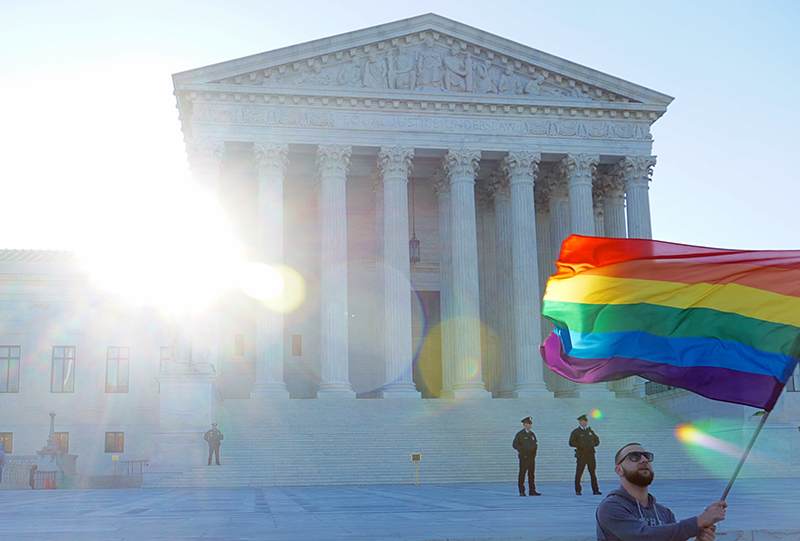It is already a truism that the Supreme Court’s June 15 six–three decision, holding that discrimination against LGBT people constitutes sex discrimination, came as a shock to queer and trans legal advocates. With the replacement by Brett Kavanaugh of Anthony Kennedy, who tended to favor gay rights, and with John Roberts joining the dissenters in the 2015 same-sex marriage case Obergefell v. Hodges, it looked to be five solid votes against the gay and transgender employees in the three cases consolidated as Bostock v. Clayton County. Plans for protests were already in the works if the Court, as expected, greenlighted the firing of Gerald Bostock and Donald Zarda, two gay men, and of Aimee Stephens, a transgender woman.
It is fascinating—and perhaps should give us pause—that it is Alito’s apoplectic dissenting opinion which adheres to the classic gender studies distinction between biological sex and gender.
Likewise, conservatives were not worried, since it seemed unimaginable that this Court would find room for queer and trans people under the carapace of a law passed fifty-six years ago ostensibly to protect women in the workforce. Such a major policy shift, they thought, would be legislating from the bench. (In the last few years, sex discrimination caselaw at the appellate level has been trending toward transgender plaintiffs; it remained more divided on the question of sexual orientation. The transition to a Trump-dominated judiciary is not yet complete in the circuit courts.) Last fall, two attorneys from the conservative First Liberty Institute confidently predicted victory for the employers: “As the maxim goes, Congress does not hide elephants in mouseholes. All things considered, it seems likely that this Supreme Court will continue to leave such large policy shifts to the discretion of Congress.”
That prediction failed, dramatically. For Neil Gorsuch, who authored the majority opinion, and the five other justices who sided with the gay and transgender parties, the logic “follows ineluctably from the statutory text.” One cannot fire a gay, lesbian, bisexual, or transgender person without taking sex into consideration.
With regard to sexual orientation, if a woman who brings her female spouse to an office party is fired, but a man who brings his female spouse to a party is not, that is sex discrimination, plain and simple. But for the sex of her spouse, the employee would not have been fired. For the Court, it’s that straightforward.
Gorsuch’s description of discrimination against transgender people is especially refreshing. It cuts through the usual carefully couched language of trans rights advocates themselves and proceeds directly to its point:
Or take an employer who fires a transgender person who was identified as a male at birth but who now identifies as a female. If the employer retains an otherwise identical employee who was identified as female at birth, the employer intentionally penalizes a person identified as male at birth for traits or actions that it tolerates in an employee identified as female at birth.
Outside of a brief description of Stephens’s history, notably absent is any discussion of, let alone reliance on, the psychiatric diagnosis of “gender dysphoria” which often dominates the analysis in the lower courts’ positive rulings. Or even of “gender identity”—a term most trans people, educators, and advocates (including myself) have used as an explanatory rubric but which has proven somewhat difficult for the non-trans public to parse. Instead, it’s just sex: the sex one was identified as at birth and the sex one identifies as now. The employees and the employers may disagree about how sex should be defined, but it doesn’t matter, says Gorsuch. The majority opinion provisionally accepts the employers’ definition of sex as biological, referring to male or female, because the employees’ counsel conceded it and because “nothing in our approach turns on the outcome” of this definitional debate. But there’s no need for dicta on the relation between sex and gender, for sociological explanations of gender normativity, or for the invocation of medical authority to lend legitimacy to the sex one identifies as now.
Until recently, the obstacles that trans people faced in getting state actors to reclassify their sex were effects of the state-sponsored oppression of women. These policies harmed trans people only incidentally (even if, for conservatives, happily).
What makes the decision so startling to both sides is how thoroughly a Court dominated by conservatives has tossed out the old common sense about sex, which was that one cannot change it. That common sense appears in a 1984 appellate decision on a Title VII claim brought by a pilot who had been summarily fired when she transitioned: “It is clear from the evidence that if Eastern did discriminate against Ulane, it was not because she is female, but because Ulane is a transsexual—a biological male who takes female hormones, cross-dresses, and has surgically altered parts of her body to make it appear to be female.” That line of thinking is gone now in Bostock v. Clayton County.
What’s more, to justify his reading of Title VII, Gorsuch invoked the interpretive method, called textualism, championed by Antonin Scalia (whose seat he filled) and generally favored by conservatives: a statute, the heuristic holds, should be interpreted according to the “ordinary public meaning” of the statute’s language at the time the law was passed. It doesn’t matter that the parties (here referring broadly to LGBT people) “happened to be unpopular at the time of the law’s passage,” writes Gorsuch. The “starkly broad terms” of the statute, he continues, “virtually guaranteed that unexpected applications would emerge over time.” In 1974, for example, a federal district court held that firing an employee for refusing her boss’s sexual advances did not offend Title VII. The decision in Bostock v. Clayton County is therefore not judicial policymaking, according to the opinion. It’s merely another example of an unanticipated yet text-driven outcome. “This elephant has never hidden in a mousehole: it has been standing before us all along,” writes Gorsuch. But few saw it then. Of course, public opinion has shifted radically in the intervening years: 83 percent of the public now believes it should be illegal to fire employees because of their sexual orientation and 79 percent believes the same for transgender workers.
The opinion thus vaults over the cautious approach taken by the ACLU during oral argument, which built on the sex stereotyping caselaw by presenting Stephens as being harmed because she was “insufficiently masculine” for people assigned male at birth. Although the opinion accepts, for the sake of argument, the ACLU’s concession that sex refers to the “biological distinctions between male and female,” there is no mention of biology after that. The opinion’s reliance on “sex” provides a bracingly clear just-the-facts account devoid of the ontological angst usually present in debates about sex and gender. Advocates say sex as “assigned at birth”; Gorsuch says as “identified at birth.” Advocates usually describe an individual’s gender identity; Gorsuch says “who later identify as” men or women.
It is fascinating—and perhaps should give us all pause—that it is Samuel Alito’s apoplectic dissenting opinion which adheres to the classic gender studies distinction between biological sex and gender and which refers several times to gender identity. Gorsuch, conversely, departs from the usual characterization of gender identity as a property—one’s interior sense of oneself as male or female or neither—and centers his decision entirely around actions. Employers fire, single out, discriminate (against), penalize. Infants are “identified as” male or female, presumably by doctors or hospital clerks. Individuals later “identify as” male or female. (Nonbinary is not mentioned in the majority opinion, though in his dissent Alito frets—and not in a good way—about what the majority’s ruling will mean for “gender fluid” employees.) Individuals are penalized for particular “traits or actions.” The only relatively fixed relationship is between the employer and employee.
There is no doubt that this decision will make a real difference in the lives of many queer, trans, and, potentially, nonbinary workers. It will also certainly be invoked in litigation against the rule changes made by the Trump administration that undid Obama-era interpretations of sex to include gender identity. But it is weird, even uncomfortable, for a conservative Court to deliver a tremendous legal victory for LGBTQ rights in the midst of the Trump administration’s assault on what’s left of the social safety net, on workers, on the environment, on reproductive justice, on migrants, on people of color. So what is really going on in the majority’s opinion, and what understanding of the relationship between sex and the law underpins it?
In the past few years, I’ve been looking closely at sex reclassification policies—those that regulate how, and under what circumstances, agencies and courts will allow an individual to change their sex classification. It is a policy area distinct from, but adjacent to, sex discrimination law. I was initially drawn to the contradictions: Why would the same individual in some cases be classified as M by one state actor and as F by another? For example, why would a woman who has an F on her birth certificate be declared M for the purposes of marriage? After wading through hundreds of policies and decisions on sex reclassification, it was clear that these contradictory policies couldn’t be adequately explained by the presence or absence of transphobia, which led me to three conclusions.
First, sex, as a legal decision backed by the force of law, does not operate as a thing in itself but as a technology of governing. Because different agencies do different things, sex is called upon to do different kinds of work. Sometimes it is a tool for nation-building, as in marriage law. Sometimes it is a tool for surveillance, as in identity documents.
Second, until recently, the obstacles that trans people faced in getting state actors to reclassify their sex were also effects of the state-sponsored oppression of women. In European and, later, American legal traditions, gender difference was codified in laws designed to limit the rights and resources available to white women (women of color were already controlled by racial regimes). Sex reclassification policies that harm transgender people therefore do so only incidentally (even if, for conservatives, happily) as a residual effect of the use of the categories of male and female to distribute rights and resources.
What disadvantages trans and queer people the most is not individual or corporate or even state-sanctioned transphobia or homophobia but the structures and processes of late racial capitalism, which conservatives continue to police ferociously even as they relax their grip on sex.
Third, now that sex has been largely though not entirely (see abortion) decommissioned as a formal mechanism for this maldistribution—Obergefell v. Hodges was perhaps its death knell—the stakes in reclassification are much lower, and so obstacles to sex reclassification have fallen quickly in the last decade. The structural privileges accorded to particular types of people—male, heterosexual, cisgender: that is, “heads” of households—are beginning to matter less as market logics favor fungibility over status. Certainly, the right has tried, not entirely successfully, to enroll transgender rights in the culture wars, and the barriers to sex reclassification that remain are now more likely to reflect red state politics.
But it also highlights the fact that increasingly what disadvantages trans and queer people the most is not individual or corporate or even state-sanctioned transphobia or homophobia but the structures and processes of late racial capitalism, which conservatives continue to police ferociously even as they relax their grip on sex. These include the use of state violence and incarceration as a system of social control, a minimum wage lagging far behind a living wage, a privatized health care system, and government policies bent on maintaining a carbon-based infrastructure, among other things, all of which are leveraged to keep the poor and people of color secured as a servile class.
Attached to normative whiteness, the potency of sex as a distributive tool is diminishing, as Gorsuch’s opinion makes evident. But it is still put to work in the service of anti-poor and anti-BIPOC violence. For example, the area where there has been the least headway in thinking about sex is in prisons. The vast majority of prisoners in the United States are still segregated according to their genitals, transition-related care is mostly withheld, and trans and gender nonconforming prisoners are often forced to choose between solitary confinement and physical violence and harassment.








